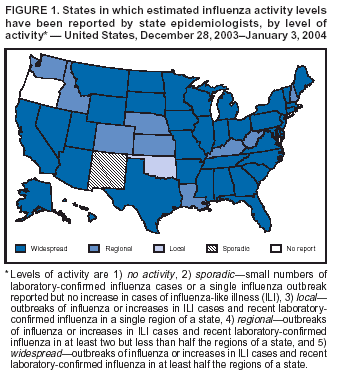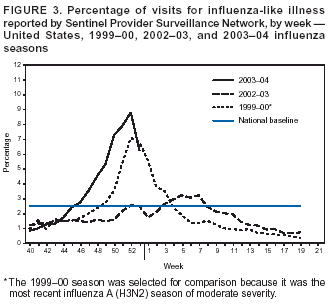 |
|
|
|
|
|
|
|
|
|
|
|
|
|
|
|
|
||||
| ||||||||||
|
|
|
|
Update: Influenza Activity --- United States, December 21, 2003--January 3, 2004The number of states reporting widespread influenza activity* decreased during December 21, 2003--January 3, 2004†. During the latest reporting week, ending January 3, health departments in 38 states, the District of Columbia, and New York City reported widespread influenza activity. Nine states reported regional activity, one state reported local activity, and one state and Guam reported sporadic activity (Figure 1). The percentage of outpatient visits for influenza-like illness (ILI)§ decreased in all surveillance regions during the week ending January 3, with an overall national percentage of 6.2%. This percentage is above the national baseline¶ of 2.5%. The percentage of specimens testing positive for influenza also decreased; however, the percentage of deaths attributed to pneumonia and influenza (P&I) increased. Laboratory SurveillanceDuring the reporting week of December 28, 2003--January 3, 2004, World Health Organization (WHO) laboratories reported testing 3,092 specimens for influenza viruses, of which 641 (20.7%) were positive. Of these, 111 were influenza A (H3N2) viruses, 524 were influenza A viruses that were not subtyped, and six were influenza B viruses. Since September 28, 2003, WHO and National Respiratory and Enteric Virus Surveillance System laboratories have tested 57,831 specimens for influenza viruses, of which 16,174 (28.0%) were positive. Of these, 16,065 (99.3%) were influenza A viruses, and 109 (0.7%) were influenza B viruses. Of the 16,065 influenza A viruses, 3,927 (24.4%) have been subtyped; 3,926 (99.9%) were influenza A (H3N2) viruses, and one (0.1%) was an influenza A (H1) virus. Antigenic CharacterizationOf the 461 influenza viruses collected by U.S. laboratories since October 1, 2003, and characterized antigenically by CDC, 454 were influenza A (H3N2) viruses, two were influenza A (H1) viruses, and five were influenza B viruses. The hemagglutinin proteins of the influenza A (H1) viruses were similar antigenically to the hemagglutinin of the vaccine strain A/New Caledonia/20/99. Of the 454 influenza A (H3N2) isolates that have been characterized, 98 (21.6%) were similar antigenically to the vaccine strain A/Panama/2007/99 (H3N2), and 356 (78.4%) were similar to a drift variant, A/Fujian/411/2002 (H3N2)**. Four influenza B viruses characterized were similar antigenically to B/Sichuan/379/99 and one was similar antigenically to B/Hong Kong/330/2001. P&I Mortality SurveillanceDuring the reporting week of December 21--December 27, 2003, P&I accounted for 9.0% of all deaths reported through the 122 Cities Mortality Reporting System and increased to 9.4% during the reporting week of December 28, 2003--January 3, 2004. The epidemic threshold†† was 7.9% and 8.0% for each reporting week, respectively (Figure 2). ILI SurveillanceThe percentage of patient visits§§ to approximately 1,000 U.S. sentinel providers nationwide for ILI decreased from 8.8% during the week ending December 27 to 6.2% for the week ending January 3, but remained above the national baseline of 2.5% (Figure 3). The percentage of patient visits for ILI decreased in all nine surveillance regions¶¶ during the week ending January 3. On a regional level, the percentage of visits for ILI was highest in the West South Central region (8.3%), followed by Pacific region (7.1%), East North Central region (6.8%), South Atlantic region (6.4%), Mid-Atlantic region (6.2%), East South Central region (4.8%), New England region (4.6%), West North Central region (4.5%), and the Mountain region (3.4%). Activity Reported by State and Territorial EpidemiologistsDuring the week ending January 3, influenza activity was reported as widespread in 38 states (Alabama, Alaska, Arizona, Arkansas, California, Connecticut, Delaware, Florida, Georgia, Hawaii, Illinois, Indiana, Iowa, Maine, Maryland, Massachusetts, Michigan, Minnesota, Mississippi, Missouri, Montana, Nevada, New Jersey, New York, North Carolina, North Dakota, Ohio, Pennsylvania, Rhode Island, South Carolina, South Dakota, Tennessee, Texas, Utah, Vermont, Virginia, Wisconsin, and Wyoming), the District of Columbia, and New York City. Regional activity was reported in nine states (Colorado, Idaho, Kansas, Kentucky, Louisiana, Nebraska, New Hampshire, Washington, and West Virginia). Oklahoma reported local activity, and New Mexico and Guam reported sporadic activity. Oregon did not report. During the week ending December 27, health departments in 42 states, the District of Columbia, and New York City reported widespread influenza activity, and eight states reported regional activity. Weekly updates on influenza activity will be published in MMWR during the influenza season. Additional information about influenza activity is available from CDC at http://www.cdc.gov/flu. *Levels of activity are 1) no activity, 2) sporadic---small numbers of laboratory-confirmed influenza cases or a single influenza outbreak reported but no increase in cases of influenza-like illness (ILI), 3) local---outbreaks of influenza or increases in ILI cases and recent laboratory-confirmed influenza in a single region of a state, 4) regional---outbreaks of influenza or increases in ILI cases and recent laboratory-confirmed influenza in at least two but less than half the regions of a state, and 5) widespread---outbreaks of influenza or increases in ILI cases and recent laboratory-confirmed influenza in at least half the regions of a state. † Provisional data reported as of January 7, 2004. § Temperature of >100.0º F (>37.8º C) and cough and/or sore throat in the absence of a known cause other than influenza. ¶ Calculated as the mean percentage of visits for ILI during noninfluenza weeks, plus two standard deviations. Wide variability in regional data precludes calculating region-specific baselines and makes it inappropriate to apply the national baseline to regional data. ** Although vaccine effectiveness against A/Fujian/411/2002-like viruses might be less than that against A/Panama/2007/99-like viruses, the current U.S. vaccine probably will offer some cross-protective immunity against the A/Fujian/411/2002-like viruses and reduce the severity of disease. †† The expected baseline proportion of P&I deaths reported by the 122 Cities Mortality Reporting System is projected by using a robust regression procedure that applies a periodic regression model to the observed percentage of deaths from P&I during the preceding 5 years; the epidemic threshold is 1.645 standard deviations above the seasonal baseline percentage. §§ National and regional percentage of patient visits for ILI are weighted on the basis of state population. ¶¶ New England=Connecticut, Maine, Massachusetts, New Hampshire, Rhode Island, and Vermont; Mid-Atlantic=New Jersey, New York City, Pennsylvania, and Upstate New York; East North Central=Illinois, Indiana, Michigan, Ohio, and Wisconsin; West North Central=Iowa, Kansas, Minnesota, Missouri, Nebraska, North Dakota, and South Dakota; South Atlantic=Delaware, Florida, Georgia, Maryland, North Carolina, South Carolina, Virginia, District of Columbia, and West Virginia; East South Central=Alabama, Kentucky, Mississippi, and Tennessee; West South Central=Arkansas, Louisiana, Oklahoma, and Texas; Mountain=Arizona, Colorado, Idaho, Montana, Nevada, New Mexico, Utah, and Wyoming; and Pacific=Alaska, California, Hawaii, Oregon, and Washington. Figure 1  Return to top. Figure 2  Return to top. Figure 3  Return to top.
Disclaimer All MMWR HTML versions of articles are electronic conversions from ASCII text into HTML. This conversion may have resulted in character translation or format errors in the HTML version. Users should not rely on this HTML document, but are referred to the electronic PDF version and/or the original MMWR paper copy for the official text, figures, and tables. An original paper copy of this issue can be obtained from the Superintendent of Documents, U.S. Government Printing Office (GPO), Washington, DC 20402-9371; telephone: (202) 512-1800. Contact GPO for current prices. **Questions or messages regarding errors in formatting should be addressed to mmwrq@cdc.gov.Page converted: 1/8/2004 |
|||||||||
This page last reviewed 1/8/2004
|